How to Build Company Culture in A Global, Distributed Team
In this article, you will learn about How to Build Company Culture in A Global Team. Learn effective strategies to foster a strong, inclusive culture for your distributed call center/BPO team.
5 min read
On this page
How to build company culture in a global, distributed team is increasingly becoming a critical conversation among CEOs, HR managers, and operations managers in call centers and BPOs.
With the proliferation of remote work and the seamless integration of global teams, companies are no longer confined to a single geographical location. Instead, they span continents and time zones, bringing together a diverse group of employees. This diversity can lead to significant competitive advantages but also poses challenges in nurturing a cohesive and robust company culture.
Building a strong company culture in the context of a distributed workforce is paramount for several reasons. Firstly, it can significantly impact employee engagement and productivity. According to a report by Harvard Business Review, companies with strong cultures have employees who are 26% more likely to be engaged (HBR, 2019). Secondly, a strong company culture can lower turnover rates. A Columbia University study found that the likelihood of job turnover in low company culture environments is 48.4%, whereas it’s just 13.9% in high company culture environments (Columbia University, 2021).
In the call center and BPO industry, where employee morale and motivation directly influence performance, understanding the nuances of building a robust global culture is vital.
This blog post will delve into actionable strategies and practical tips to build company culture in a global, distributed team. We will reference the latest statistics and research to back our suggestions, ensuring you have reliable information to guide your efforts. So, if you’re ready to create a thriving company culture that transcends borders, let’s dive right in!

Understanding Cultural Differences and Values in A Global Team
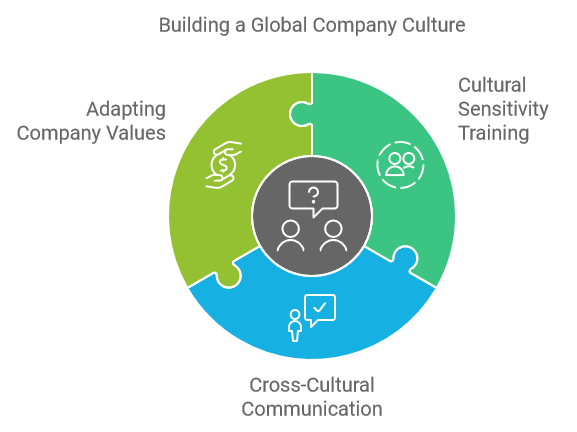
One of the foundational steps in building company culture in a global, distributed team is understanding cultural differences and values. Every region has its unique cultural norms and practices, and recognizing these can help you foster an inclusive and respectful environment.
No two cultures are the same, and when building a global company culture, it’s vital to understand and respect these differences. Here’s how you can do this:
Conduct Cultural Sensitivity Training
Provide training sessions for your employees to understand the cultural backgrounds of their colleagues. According to a report by Glassdoor, companies that invest in diversity and inclusion see a 2.3 times higher cash flow per employee over three years (Glassdoor, 2020). This training can cover topics such as communication styles, workplace etiquette, and common cultural practices.
Pro Tip: Use tools like Hofstede’s Cultural Dimensions Theory to grasp the key differences between cultures. For example, individualism versus collectivism is a significant dimension that impacts workplace behavior.
Encourage Cross-Cultural Communication
Facilitate regular meetings or virtual hangouts where team members from different cultural backgrounds can share their customs and traditions. This will not only enhance mutual respect but also promote a sense of unity and belonging.
Pro Tip: Use collaboration tools like Slack channels or Microsoft Teams to create dedicated spaces where people can share their cultural stories and experiences.
Adapt Company Values to Reflect Cultural Diversity
Ensure that your company’s core values consider and integrate various cultural perspectives. This inclusiveness will make all employees feel valued and integral to the company’s mission.
Pro Tip
Create a global culture committee that periodically reviews company values to ensure they align with the diversity within the team.
Effective Communication Strategies for A Distributed Team
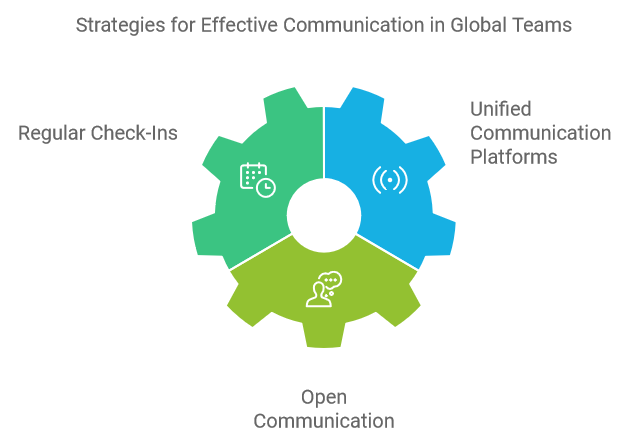
Clear and effective communication is the cornerstone of a good company culture, especially for a global, distributed team. The lack of face-to-face interaction can lead to misunderstandings and feelings of isolation. Here, we outline strategies to bridge the communication gap.
Implement Regular Check-Ins
Schedule daily or weekly check-ins to ensure that everyone is on the same page. These meetings can serve as an excellent platform for addressing any concerns and clarifying any ambiguities.
Pro Tip: Use video conferencing tools like Zoom or Google Meet for these check-ins to add a personal touch and enhance engagement.
Utilize Unified Communication Platforms
Adopt platforms that consolidate all your communication channels such as emails, instant messaging, and video calls. This makes it easier for teammates to stay connected irrespective of their location.
Pro Tip: Tools like Slack and Microsoft Teams are excellent for integrating various communication channels, promoting seamless interactions.
Promote Open Communication
Create an environment where employees feel comfortable sharing their thoughts and ideas. Open communication fosters innovation and makes everyone feel part of the team.
Pro Tip
Use anonymous feedback tools like SurveyMonkey to regularly gauge employee sentiment and listen to their concerns.
Fostering Team Collaboration in A Global Team
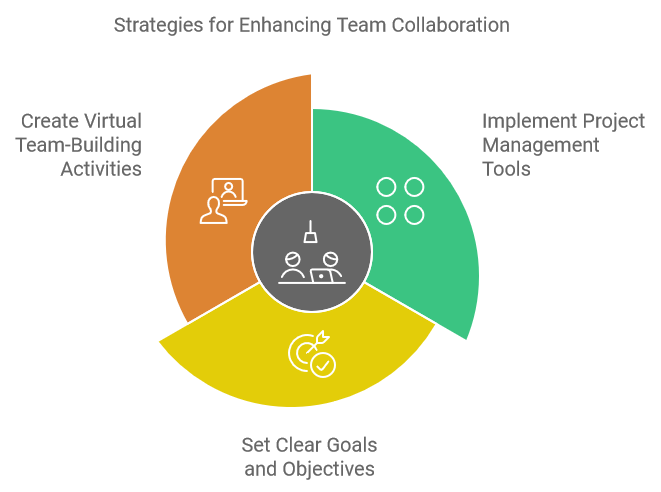
Team collaboration in a global, distributed workforce can be challenging but not impossible. Below are some strategies to promote better teamwork.
Implement Project Management Tools
Use project management tools to keep track of tasks and deadlines. These tools can help teams from different time zones collaborate efficiently.
Pro Tip: Ensure that your project management software integrates seamlessly with your communication tools for better coordination.
Set Clear Goals and Objectives
Define clear, achievable goals to ensure everyone knows what they’re working towards. This helps in maintaining focus and productivity.
Pro Tip: Use the SMART criteria (Specific, Measurable, Achievable, Relevant, Time-bound) to set your goals.
Create Virtual Team-Building Activities
Engage team members in virtual team-building activities such as online games, quizzes, or virtual happy hours. This can boost morale and foster a sense of community.
Pro Tip
Use platforms like Kahoot or Jackbox Games for interactive and fun team-building sessions.
Recognizing and Rewarding Employees in A Global Team
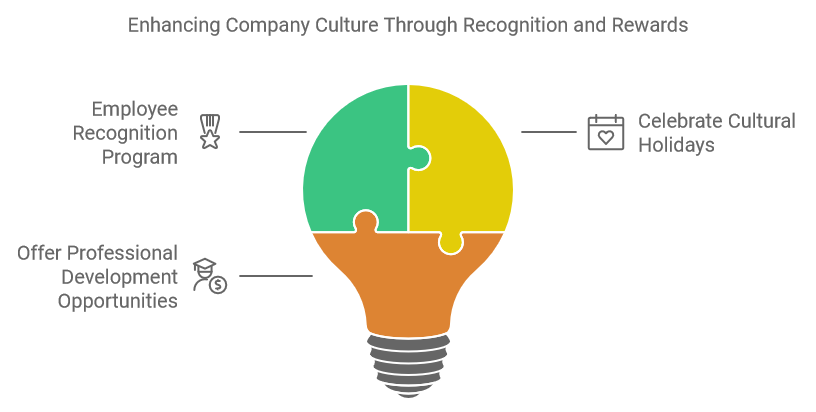
Recognition and rewards play a pivotal role in building a strong company culture. Here are some ways to show appreciation to your global, distributed team.
Implement an Employee Recognition Program
Set up a formal employee recognition program to acknowledge outstanding performance. According to a survey by Gallup, organizations that practice employee recognition experience a 28% reduction in absenteeism and a 31% increase in productivity (Gallup, 2017).
Pro Tip: Use platforms like Bonusly or Kudos for streamlined and effective employee recognition programs.
Celebrate Cultural Holidays
Recognize and celebrate cultural holidays from the different regions your employees are from. This fosters inclusivity and boosts morale.
Pro Tip: Use a shared calendar to mark these holidays and organize small virtual celebrations to make employees feel valued.
Offer Professional Development Opportunities
Provide opportunities for learning and development. This shows employees that the organization is invested in their growth and career progression.
Pro Tip
Partner with online learning platforms like Coursera or Udemy to offer courses relevant to your team’s professional development.
Maintaining Work-Life Balance in A Distributed Team
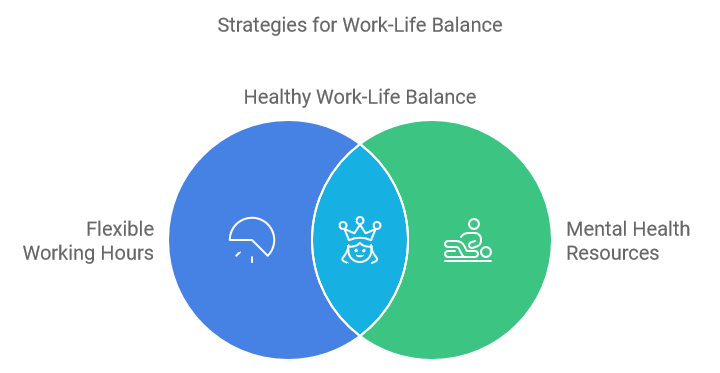
Ensuring a work-life balance is crucial for the well-being of your employees. Here are some strategies to help them maintain a healthy balance.
Encourage Flexible Working Hours
Allow employees to choose working hours that align with their personal lives and time zones. This can significantly reduce burnout and improve overall satisfaction.
Pro Tip: Use time-tracking tools like Toggl to monitor productivity without being intrusive.
Promote Mental Health Resources
Provide access to mental health resources such as counseling services or stress management workshops. According to the World Health Organization, for every $1 invested in mental health, there is a $4 return in improved health and productivity (WHO, 2019).
Pro Tip: Partner with mental health platforms like BetterHelp or Headspace to offer these resources to your team.
Set Clear Boundaries
Encourage employees to set clear boundaries between work and personal life to avoid burnout. This includes defining ‘offline’ hours where they are not expected to respond to work-related communications.
Pro Tip
Use email and messaging tools that allow you to set 'do not disturb' hours to help maintain these boundaries.
Measuring and Improving Company Culture in A Global Team
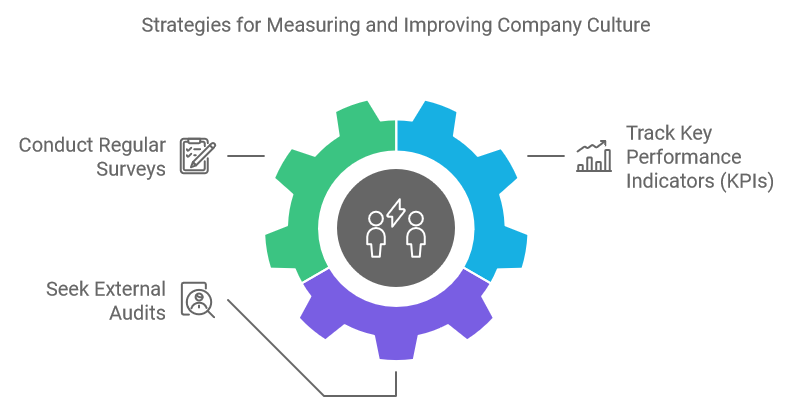
Finally, it’s essential to measure and continually improve your company culture. Here are some strategies to consider:
Conduct Regular Surveys
Use employee surveys to gauge the effectiveness of your cultural initiatives. This feedback can provide valuable insights into what’s working and what needs improvement.
Pro Tip: Use survey tools like SurveyMonkey or Qualtrics to collect and analyze this data efficiently.
Track Key Performance Indicators (KPIs)
Identify and track KPIs related to employee engagement, satisfaction, and retention. This will give you quantifiable metrics to assess your company culture.
Pro Tip: Use HR software like BambooHR or Workday to monitor these KPIs and generate reports.
Seek External Audits
Consider hiring external consultants to audit your company culture and provide impartial recommendations for improvement.
Pro Tip: Use firms specializing in workplace culture audits, like Great Place to Work, to get a comprehensive analysis.
By understanding cultural differences, fostering effective communication, enhancing collaboration, recognizing employees, and maintaining work-life balance, you will be well on your way to building a strong and inclusive company culture in your global, distributed team. Continuously measuring and improving these initiatives will ensure long-term success and a thriving work environment.
